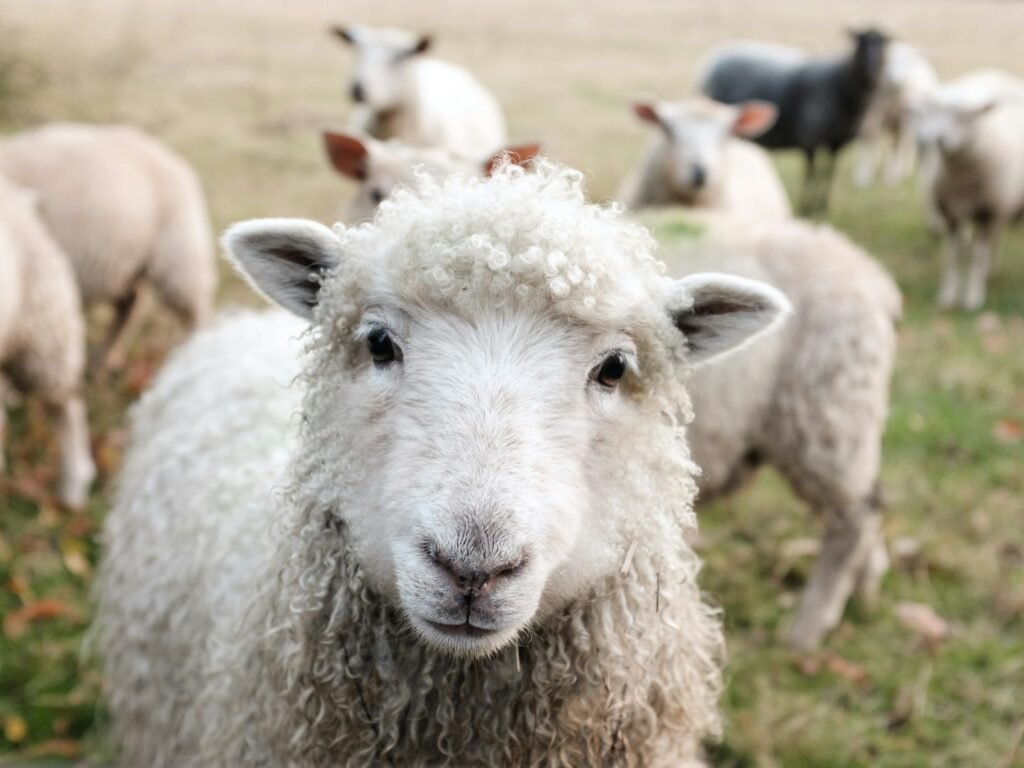Have you ever wondered about the deeper meanings behind the symbols found in religious texts? In the Bible, the lamb holds significant symbolism, representing concepts such as innocence, sacrifice, redemption, protection, and peace. What is the biblical meaning behind these representations? Explore the rich symbolism of the lamb in the Bible and uncover its profound significance in Christian faith and redemption narratives.
Table of Contents
The Lamb as a Symbol of Innocence
In the Bible, the lamb holds deep symbolic meaning, particularly as a representation of innocence. Throughout biblical texts, the lamb is associated with purity and moral uprightness, embodying the essence of innocence.
This symbolism of innocence can be traced back to the story of Abel in the book of Genesis. In his act of offering a lamb as a sacrifice to God, Abel not only demonstrates his faith but also emphasizes the lamb’s role as a symbol of moral purity.
Later passages further highlight the lamb’s connection to innocence. In Isaiah 11:6, the lamb is described as being without blemish or sin, reinforcing its association with purity. Similarly, in John 1:29, John the Baptist refers to Jesus as the “Lamb of God,” underscoring his sinless nature and the innocence he represents.
The lamb is a powerful symbol of innocence in the Bible, representing purity and moral righteousness. Its significance can be seen in the story of Abel, as well as in passages that describe the lamb as without blemish or sin.
The notion of innocence conveyed through the lamb’s symbolism is a recurring theme in biblical narratives. Its presence serves as a reminder of humanity’s potential for moral integrity and the importance of maintaining an innocent heart.

The Lamb as a Symbol of Sacrifice
In the Bible, the lamb holds deep symbolism, and one of its significant meanings is that of sacrifice. Sacrificing a lamb was a common practice in ancient times, serving as a way to atone for sins and seek reconciliation with God. The act of offering a lamb as a sacrifice was seen as a solemn and solemn act of devotion and repentance.
The act of offering a lamb as a sacrifice was a way for individuals to demonstrate their commitment to seeking forgiveness and restoration. It was a tangible expression of their desire to turn away from sin and reconcile with God.
In the Old Testament, the Passover lamb played a prominent role in the liberation of the Israelites from Egypt. The lamb’s blood was painted on the doorposts, protecting the Israelites from the final plague, while its flesh was consumed during the Passover meal. This sacrifice served as a reminder of God’s deliverance and marked the beginning of a new chapter for the Israelites.
In the New Testament, Jesus is frequently referred to as the Lamb of God. His sacrificial death on the cross is seen as the ultimate act of sacrifice, offering redemption for humanity’s sins. Through his selfless and sacrificial act, Jesus fulfilled the Old Testament prophecies and provided a way for people to be reconciled with God.
Jesus, as the Lamb of God, willingly offered himself as a sacrifice out of love and obedience to God. His sacrifice represents the ultimate act of love and redemption, providing a pathway for all who believe in him to find forgiveness and eternal life.
The symbolism of the lamb as a sacrifice highlights the biblical understanding that true redemption comes at a cost. It emphasizes the gravity of sin and the need for a perfect sacrifice to restore the relationship between humanity and God.
Ultimately, the lamb’s role as a symbol of sacrifice underscores the biblical narrative of God’s love and mercy, offering a way for people to find forgiveness, reconciliation, and eternal peace.
The Lamb as a Symbol of Redemption
In the Bible, the lamb is closely associated with the concept of redemption. It symbolizes the sacrificial act of Jesus Christ, who is often referred to as the Lamb of God and the ultimate source of redemption for humanity.
The lamb’s sacrifice is seen as a means of bringing salvation and forgiveness of sins. Through his death on the cross, Jesus redeemed humanity and offered the opportunity for spiritual rebirth and eternal life.
This symbolism of redemption is particularly emphasized in the book of Revelation. In Revelation 5:5-6, the lamb is described as the only one worthy to open the seals and bring about God’s ultimate plan for redemption.
“Then one of the elders said to me, ‘Do not weep! See, the Lion of the tribe of Judah, the Root of David, has triumphed. He is able to open the scroll and its seven seals.’ Then I saw a Lamb, looking as if it had been slain, standing at the center of the throne.” – Revelation 5:5-6
This depiction of the lamb as the central figure in God’s plan of redemption signifies its immense importance in Christian theology. The lamb’s sacrificial role represents the ultimate act of love and selflessness, emphasizing the power of redemption and the restoration of a broken relationship between humanity and God.
Symbolic Redemption Through the Lamb’s Sacrifice
The symbolism of redemption through the lamb’s sacrifice can be understood by examining its significance in the Passover feast. In the Old Testament, the Israelites were instructed to sacrifice a lamb and mark their doorposts with its blood to protect their households from the angel of death during the plague on the firstborn.
Similarly, Jesus, as the sacrificial lamb, offers protection from the consequences of sin and spiritual death. His sacrifice symbolizes the redemption and liberation of humanity from the bondage of sin, offering a path to spiritual freedom and eternal life.
Through faith in Jesus’ sacrificial act, individuals can experience the transformative power of redemption, finding forgiveness and reconciliation with God.
Symbolic Meanings of the Lamb in Christian Theology
| Lamb Symbolism | Meaning |
|---|---|
| Innocence | The lamb represents purity and moral uprightness. |
| Sacrifice | The lamb’s sacrifice symbolizes the atonement of sins. |
| Redemption | The lamb represents the act of Jesus redeeming humanity through his death on the cross. |
| Protection | The lamb symbolizes God’s role as a shepherd, offering guidance and protection. |
| Peace | The lamb is associated with harmony and the absence of conflict. |
| Jesus Christ | Jesus is often referred to as the Lamb of God, symbolizing his sacrificial role in redemption. |
The Lamb as a Symbol of Protection
In biblical texts, the lamb is not only a symbol of innocence, sacrifice, and redemption but also represents protection. The book of Psalms portrays the Lord as a good shepherd who guides and protects his flock, just as a shepherd protects his lambs.
“The Lord is my shepherd; I shall not want. He makes me lie down in green pastures. He leads me beside still waters. He restores my soul.” – Psalm 23:1-3
This imagery emphasizes the vulnerability of the lamb and the shepherd’s role in providing safety and care. It reflects the loving and nurturing nature of God towards his people, ensuring their well-being and protection.
The Shepherd’s Guidance and Protection
The symbolism of the lamb as protection stems from the shepherd’s duty to safeguard the flock. Shepherds actively ensure the safety of their lambs by guiding them away from dangers, such as predators or treacherous terrain.
This analogy extends to the relationship between God and his people. The Lord, depicted as the ultimate shepherd, takes on the responsibility of protecting and guiding his followers, similar to how a shepherd protects his lambs from harm.
God’s Loving and Nurturing Nature
In addition to physical protection, the symbolism of the lamb as protection also underscores the divine love and care of God for his people. The bond between the shepherd and the lamb signifies a close and intimate relationship, rooted in trust.
God’s role as the protector of his people exemplifies his commitment to their well-being. Just as a shepherd ensures the safety of the lambs under his care, God’s love and nurturing nature provide a sense of security and comfort to his followers.
Seeking Shelter Under God’s Protection
Understanding the lamb as a symbol of protection encourages believers to seek refuge in God’s care during times of adversity. The imagery of the shepherd gathering the lambs under his watchful eyes inspires confidence and reassurance, knowing that God’s protective presence is ever-present.
By embracing the symbolism of the lamb as protection, individuals can find solace and strength in the belief that God is their ultimate guardian, providing shelter and safeguarding them from harm.
The Lamb as a Symbol of Peace
In the Bible, the lamb is often associated with peace. One prominent example is found in Isaiah 11:6, where there is a prophetic vision of a peaceful future. In this vision, the lamb coexists with the wolf, and the leopard lies down with the young goat. This imagery serves as a powerful symbol of the restoration of harmony and the absence of conflict.
The gentle and docile nature of the lamb further reinforces its connection to peace. The lamb’s calm and non-threatening demeanor stands in stark contrast to the aggression and violence often associated with other animals. It serves as a reminder of God’s desire for peace among all of His creation.
“Blessed are the peacemakers, for they will be called children of God.” – Matthew 5:9
Throughout the Bible, peace is highly valued and regarded as a divine blessing. The symbolism of the lamb as a representation of peace resonates with individuals seeking tranquility and harmony in their lives. It serves as a reminder of the peace that can be found in surrendering to God’s will and following the teachings of Jesus Christ.
Examples of Peaceful Imagery and References in the Bible:
- The lamb residing with the wolf in Isaiah 11:6
- Jesus’ instruction to turn the other cheek in Matthew 5:39
- The promise of peace from God in John 14:27
- The angels’ message of peace during the birth of Jesus in Luke 2:14
These examples highlight the biblical emphasis on peace and provide further context to the symbolism of the lamb as a representation of peace. It is a powerful image that invites individuals to seek reconciliation, practice forgiveness, and strive for peaceful coexistence with others.
| Symbolism | Biblical Reference |
|---|---|
| Peaceful coexistence | Isaiah 11:6 |
| Peace as a divine blessing | Matthew 5:9 |
| Turning the other cheek | Matthew 5:39 |
| God’s promise of peace | John 14:27 |
| Angels’ message of peace | Luke 2:14 |
The Lamb as a Symbol of Jesus Christ
In Christian theology, Jesus Christ is frequently identified as the Lamb of God. This symbolism stems from his sacrificial death on the cross, which is believed to have redeemed humanity. Jesus is often portrayed as the perfect and final sacrificial lamb who atones for the sins of the world. The lamb imagery serves to emphasize Jesus’ role as the ultimate source of redemption and salvation according to Christian beliefs.
FAQ
What does the lamb symbolize in the Bible?
The lamb holds significant symbolism in the Bible, representing concepts such as innocence, sacrifice, redemption, protection, peace, and Jesus Christ.
How is the lamb symbolized as innocence in the Bible?
The lamb represents purity and moral uprightness in the Bible, emphasizing innocence. It is often associated with offering sacrifices and described as without blemish or sin.
What is the symbolism of the lamb as sacrifice in the Bible?
The act of sacrificing a lamb was a common practice in ancient times, seen as a way to atone for sins. The Passover lamb in the Old Testament and Jesus as the Lamb of God in the New Testament exemplify this symbolism of sacrifice.
How is the lamb symbolized as redemption in the Bible?
The lamb symbolizes redemption in the Bible, particularly through the sacrificial death of Jesus on the cross. Jesus is often referred to as the sacrificial lamb who brings salvation and forgiveness of sins.
What is the symbolism of the lamb as protection in the Bible?
The lamb is depicted as a symbol of protection in biblical texts. In the book of Psalms, the Lord is described as a good shepherd who guides and protects his flock, paralleling the care a shepherd provides for their lambs.
How is the lamb symbolized as peace in the Bible?
The lamb is associated with peace in the Bible. Isaiah 11:6 envisions a peaceful future where the lamb coexists with other traditionally predatory animals, symbolizing the restoration of harmony and the absence of conflict.
How is Jesus Christ symbolized as the Lamb in the Bible?
Jesus Christ is frequently identified as the Lamb of God in Christian theology. This symbolism stems from his sacrificial death on the cross, which is believed to have redeemed humanity. Jesus is portrayed as the ultimate sacrificial lamb who atones for the sins of the world.

Rockin’ the faith, one verse at a time!
Growing up, the Bible’s stories deeply impacted me. Now, with over 15 years of preaching experience, I blend timeless teachings with modern technology, making them relevant for today’s world.
Bible Hub Verse is my platform to share historical insights and thought-provoking articles, exploring both familiar and uncommon Christian topics. My passion is building a welcoming online space for everyone to learn, grow in their faith, and discover the Bible’s enduring message.
Join the journey!
God bless you.








